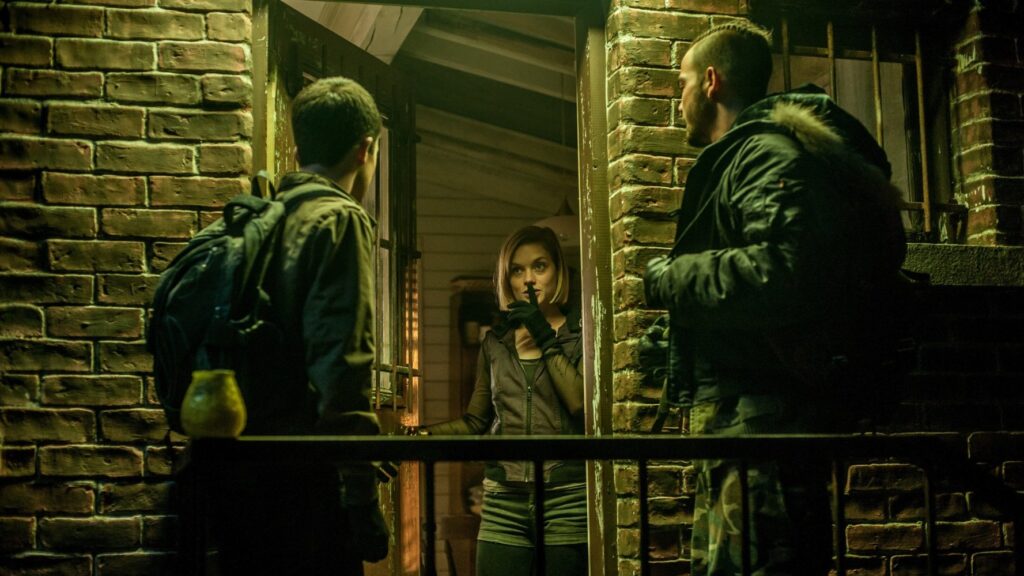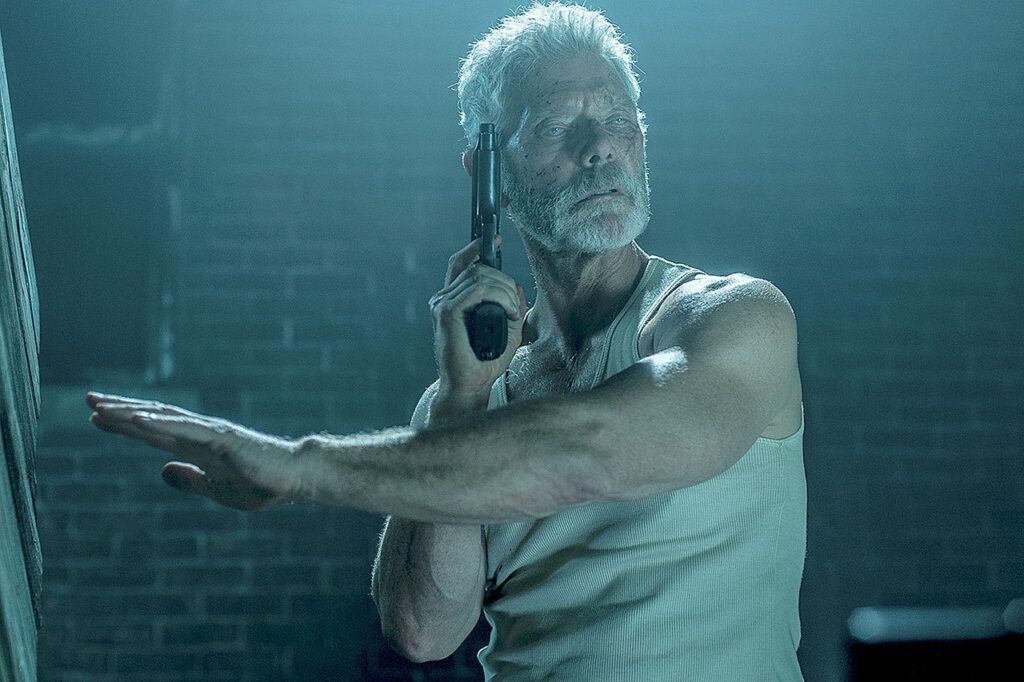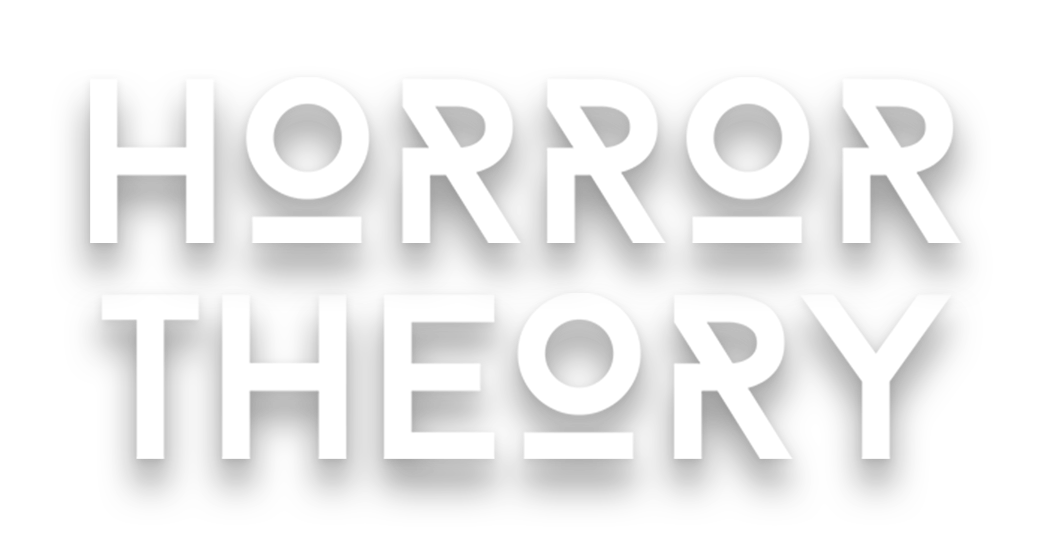2016 was a big year for horror films featuring home invasions. Hush showcased Oculus director Mike Flanagan’s exhilarating twist with a hearing-impaired protagonist. The horror sequel/spin-off 10 Cloverfield Lane served as both a monster home invasion and a claustrophobic escape act. And Better Watch Out brought unexpected Christmas flair to the psychotic killer vs babysitter set-up. But none matched the brutal intensity and subversiveness of Don’t Breathe, directed by Uruguayan filmmaker Fede Álvarez, who was launched into the horror spotlight in 2013 with his stylish remake of The Evil Dead.
Don’t Breathe follows a trio of Detroit hoodlums who receive a tip that a local Army veteran named Norman (we’ll call him The Blind Man, his horror villain name and how he’s listed in the end credits, for simplicity here forward) is sitting on a fat stack of cash— $300,000— and decide to rob him. After scoping out his run-down house in an otherwise entirely-abandoned neighborhood, they learn that the man is totally blind, making him easy prey for savvy experienced thieves. They break into the man’s home, and quickly discover that their assumptions that this would be a quick and clean operation was misguided. The Blind Man has retained all of military prowess and has somehow become more deadly sans his vision.
The home invasion trope often reflects a generation or society’s fear of an invasion of foreigners (read: immigrants and refugees). This is why so many American horror films that feature a home invasion follow the same formula: a happy white family defends their fortress from the threat of death from an unhinged, often-masked savage who takes pleasure in their agony. Often in these films, the villain’s motives are left vague or unclear. This gives audiences the opportunity to fill in the blanks and see themselves in the character waging righteous warfare against intruders. Movie viewers are subtly urged to see the intruders for whatever scapegoated group they feel threatened by in real life.

So what the hell was happening in 2016 that inspired so many horror films featuring home invasions?
Well, one important event comes to mind: the rise of Tr*mp. The Republican presidential hopeful announced his candidacy in June of 2015, with a campaign rally at Trump Tower in New York City, where he stoked fear of a foreign invasion— and linked illegal immigration to other national issues like the offshoring of American jobs and Islamic terrorism. The future-POTUS famously zeroed in on Mexican immigrants and claimed that: “They’re bringing drugs. They’re bringing crime. They’re rapists.” The remarks provided him with ample television coverage and ignited a frenzy of support from groups that were, at the time, fringe. Tr*mp planted in the minds of many Americans who felt personally victimized culturally or economically that their liberties were being revoked and their spaces violated by Mexicans, Muslims, and of course his political opponents whom he derided as socialists and globalists.
Towards the end of 2016, Vox culture staff writer Aja Romano noted in a piece entitled “Horror movies reflect cultural fears. In 2016, Americans feared invasion.” that many of the hidden fears that Americans perceived quietly came boiling to the surface when Tr*mp gave credence to those fears by discussing them publicly. Romano specified: “No longer repressed were white Americans’ fears of faceless people of color, or the insidious invading corruption of foreign influences. These anxieties, fueled by fake news, misinformation, and a web of vast and nefarious conspiracy theories, shaped the current political climate to a degree few had imagined possible.”
Notably, Don’t Breathe is a subversive entry in the home invasion horror canon, breaking away from most of the tropes that have long defined the subgenre. Typical home invasion films often celebrate the rugged individualism and toxic masculinity of its victims-turned-heroes. Filmmakers accomplish this by emphasizing the victims’ initial reluctance to turn to violence against their barbaric assailants (this is shown as a sign of weakness or even a fundamental character flaw) before embracing their violent instincts, “manning up,” and overcoming their intruders with militaristic strategy and brute force (cue the cheering from the audience). Don’t Breathe contains no such set-up and no such resolution.
Instead, the protagonists are the intruders and the victim of the home invasion shows no such hesitation to embrace brutality to blow up the thieves’ efforts to snatch his cash and bounce. The Blind Man is, afterall, a Gulf War veteran and has retained those militant skills even decades after his service. Don’t Breathe invokes audiences to question their expectations of its central characters and their violent actions. Who are the heroes of this story? Who do we root for when the guns come out? Were we primed to view the characters this way by past films? For this, we have to look at each characters’ motivations, which are revealed through backstories that are drip fed to us in the film’s 88-minute runtime.
Every on-screen character is a victim of systemic issues
Home invasion villains have given us some iconic masks to admire: the tiger, lamb, and fox masks in You’re Next, the sack mask in The Strangers, and the smiling creep mask in The Purge. These are designed to conceal the identity of the murderer in order to prolong and intensify the sense of dread that comes with being assaulted and not knowing why or by whom. But as the victim in Don’t Breathe is blind, the intruders require no cloak or camouflage. And their reasoning for robbing The Blind Man is shown before the robbery is even conceived.
The young thieves include: Rocky, Alex, and Money. Rocky, who is essentially the film’s protagonist, robs houses in order to fund a move from Detroit to Los Angeles with her younger sister in order to escape an abusive family in a desolate city. Money acts as the bad influence of the group. He robs houses because he’s simply portrayed as a bad person— an outdated character type, which might be why he’s killed off moments into the attempted heist. Alex, meanwhile, has unclear motives but is shown to have a strong moral compass. As the only middle class character of the trio, he doesn’t need to rob houses to get by and may be doing so to be closer to Rocky, whom he shows affection towards throughout. What they all have in common, The Blind Man included, is that they are all struggling to escape or make the best of their lives in early-2010s Detroit.
URBAN DECAY : ˈər-bən \ di-ˈkā (noun) : The process where a city that was once flourishing and functioning properly falls into disuse and disrepair.
According to Wikipedia, common indicators of a city in urban decay are empty plots of land, abandoned and decrepit buildings, high unemployment rates, and high crime rates. Don’t Breathe opens with a shot of The Blind Man dragging a bloodied body back to his house in the middle of the street in broad daylight. This brilliantly sets up the atmosphere of the film and the themes of urban disrepair that rot both the set locations and the hearts of every character. In the 1940s, Detroit was the fourth-largest city in the United States due in large part to the thriving automobile industry. But after auto jobs began leaving the city in the 1950s, people began to flee the so-called “Motor City” for jobs elsewhere, leaving the city lifeless with abandoned neighborhoods and a crumbling economy.
The Blind Man’s house is designed to induce the claustrophobic panic that victims of urban decay likely feel surrounded by crumbling buildings and disintegrating infrastructure. This is intensified when you take into account that The Blind Man is a military veteran, a class of Americans that are superficially praised as heroes but are often neglected socially and economically when they return home. When Don’t Breathe released in 2016, the U.S. was in its 15th year of its longest running-running war in its history and folks were beginning to question its effectiveness (especially in relation to its high costs) as well as the nation’s role in perpetuating imperialist violence. Before 2016, the idea of positioning a U.S. army veteran as the villain of a horror movie wherein he’s being targeted in a heist might’ve sparked substantial outrage.

It’s no wonder an economically-crippling city pushed Rocky to a life of crime in order to help herself and her younger sister leave behind a city that has left them to wallow in destitute. What future would she have otherwise but to continue stealing until her inevitable incarceration? She is shown stashing away cash after previous, smaller home robberies with the intention of acquiring enough capital to start fresh in California, which is often portrayed in films as the destination for those looking for a fresh start, despite having its own slew of economic challenges.
[MAJOR SPOILERS AHEAD; TRIGGER WARNING: RAPE]
Likewise, The Blind Man finds himself imprisoned by a deindustrialized Detroit following a personal tragedy that he reveals in the third act. When Rocky and Alex make their way to The Blind Man’s basement, they discover a young pregnant woman tied up in a makeshift bedroom. As their attempts to free her are quickly foiled, The Blind Man reveals that the young woman is Cindy, a wealthy woman who accidentally killed his daughter in a car accident. He impregnated Cindy with a turkey baster (in order to use her to replace his daughter) and later tries to do the same to Rocky after Cindy is accidentally shot.
Reminiscent of the crusifix masturbation scene in The Exorcist and the tree rape scene in The Evil Dead, the turkey baster scene provoked audible moans of disgust during my theater exerience. Despite many horror movie trailers of the time giving away much of the plot, Don’t Breathe managed to conceal the gruesome twist and shocked audiences worldwide. In an interview with Horror Buzz, Alvarez explains: “In the first draft of the script, he kept her in the basement and that was basically as far as we went. He had this rich girl in his basement who had killed his daughter. I mean, the girl got off scot-free and she should have been in jail so he takes matters into his own hands and imprisons her in his own house to serve out her sentence. Then we thought: What if it’s like he is trying to collect what she took away from him? What if he wants his kid back?”
In creating a scenario where The Blind Man chooses to use a turkey baster to impregnate a woman to get a new baby, Don’t Breathe gives its victim-turned-villain a tragic backstory and the slightest of moral codes (if you can call it that) as he explains defensively, “I never forced myself on any girl.” He further laments the tragedy of the situation by pointing out the classist nature of the U.S. criminal justice system: “She got off because Rich girls don’t go to prison.”
Whether or not the turkey baster scene felt essential to the narrative has been polarizing, similarly to the horror films that inspired it. Nevertheless, it effectively gave the franchise’s villain new dimensions. His experience with classism may be the only thing he has in common with his intruders. After serving in the U.S. military, it is implied that he is only able to get by financially after winning a cash settlement from a tragic car accident. Yes, The Blind Man is unequivocally the villain, but he’s also the victim of a system of armed forces that returns veterans home unprepared for civilian employment and with unaddressed mental health problems and difficulties constructing a personal identity outside of the highly-structured life that the military provides. Add to that the trauma of losing a close family member, possibly the only family that he had.
2016 certainly marked a resurgence of home invasion horror films. And while some readers may scoff at the line drawn between the subject matter on screen with the real-life paranoia that was enveloping the U.S. at the time, Don’t Breathe gave horror audiences more of what they’d expected from Uruguayan filmmaker Fede Álvarez: a tightly structured narrative, effective gruesome terror throughout, and compelling characters that you despise and sympathize with in equal measure. Don’t Breathe is one of the finest home invasion films ever made and will surely raise the bar above the tired cliches that made the subgenre so stagnant for so long before it.
***
Don’t Breathe and its sequel are available on blu ray, DVD, and digitally here. And be sure to check out the other entries in The 31-Day 2010s Fear & Now Horror-Thon right here on Horror Theory.
